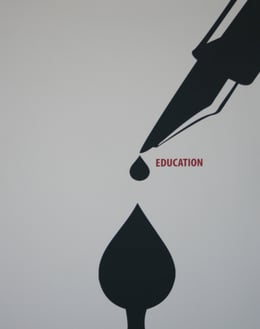Un-education: The State of Public Education in America
Dalton Nolan
8/26/2024
Public education is an important institution in America, as with it, millions of working people were given a chance to learn; this is in contrast to the majority of human history, which saw education heavily restricted to certain classes in society. However, despite the working class earning the chance to access education, public education is not designed for working people, as can be seen from the war that is being waged against it. This war against public education is barring the realization of education's rewarding impacts on tens of millions of working people. Though most working people recognize the obvious attack that budget cuts and censorship play in the assault on public education, these two things only scratch the surface of the unyielding offensive on one of our most brutalized public institutions.
At the forefront of the casualties of the war on education are the teachers. Under our present economic system, teachers are subjected to extreme abuse—they are underpaid, overworked, undersupplied, and overstressed. Teachers are underpaid as their average salary of $50k is not enough to pay the bills with an ever-increasing rise in the cost of living. Teachers are overworked because there are fewer and fewer teachers due to the nationwide teacher shortage, meaning that those remaining have to take on more students and do more work. Teachers are undersupplied because schools don’t have the budget to supply teachers with needed materials, leaving the teachers to pay out-of-pocket for supplies for all their students, racking up hundreds of dollars—an expense that excessively eats into the wallets of these teachers. Teachers are overstressed as they have to not only deal with the daily struggles of being a working person in our present economic system, but also have to carefully plan out assignments that adhere to the standards set by the state and that will engage their students and they have to also contend with a myriad of personalities, struggles, and needs that make up their students.
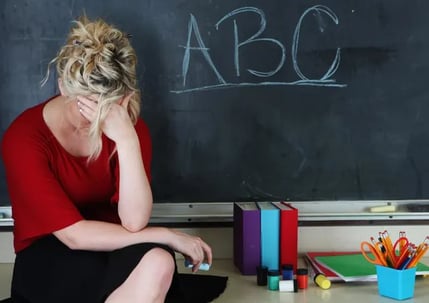

Because of all the struggles that teachers grapple with, the profession is often viewed as a labor of passion, in which the teacher always enters and leaves the classroom with a smile and accepts whatever the school, children, or life throws at them without so much as a complaint. This perception has been propagated in the media, with movies about teaching portraying the teacher as a figure unrealistically unconcerned with their material conditions and obsessively focused on the welfare of their students. This widespread stereotype has resulted in some people viewing teachers who complain about their workplace conditions as being lazy, selfish, and uncommitted to the virtuous role of being an educator. Through this, a teacher's job is transformed into an abstract ideal devoid of the practical reality of every working person needing a wage to eat and live. With this, the owning class and their allies can easily demonize teachers, making their demands for better working conditions invalidated by this simple, but dangerous stereotype. Even worse, by failing to adhere to the idealized view of teaching, teachers are used by the media to reinforce the notion that public education is failing its students. In this, the conversation on the failings of public education shifts from material issues, such as funding cuts, to the poor teachers and school staff who are simply trying to do the best they can with the meager resources and energy they have; teachers and school staff are made into scapegoats.
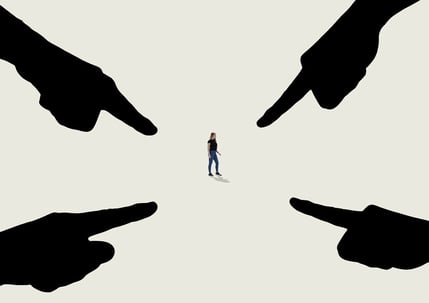

In being labeled the source of all the problems with public education, and with the media spreading this idea into the home of every working class family, it's only reasonable that parents would become worried about their child’s education, causing them to possibly become heated when interacting with teachers. The resulting heated exchanges keep parents and teachers, both working people and the biggest cheerleaders for the children, focused on and fighting each other while the real culprits behind the failings of public education—the owning class—slip by and continue destroying public education. Ultimately, under our present economic system, teachers are left with little material support and are forced to make do with dwindling resources, patience, and hope. As a result, more and more teachers are either leaving to find better employment elsewhere or taking the very real and exhausting option of working more than one job.
In our present economic system, public education is not for enlightening students, transforming them into hungry seekers of knowledge, but is designed to train future workers. By design, students are discriminated against based on a very prominent and accepted form of discrimination: standardized testing. Throughout their school experience, children are conditioned for the “Test.” The “Test” is the embodiment of the mantra “college and career ready,” with the series of tests that students take in high school being determiners of the path a student can take after graduating high school. The “Test” is the culmination of a student’s entire schooling, with testing benchmarks being their declaration that they possess the tools to head to college and earn a degree or join the workforce and kickstart their career. In this, the benchmark is the indicator of who is and who isn’t successful and, by extension, valuable. Failing to reach the benchmark is a sign of “defectiveness,” marking any student as undeserving of the benefits that come from higher education. This mark defines the student and their abilities, tarnishing their self-worth, and causing many to experience bouts of helplessness, self-hatred, and depression. Even worse, failing to reach the benchmark serves as a rallying cry for peers to ridicule the student, dividing students into narrowly-defined groupings of “smart” and “dumb.”
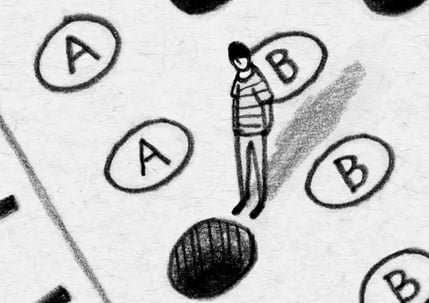

Once the groupings of “smart” and “dumb” are cemented, the othering of students is reinforced through classifications, race, gender, and more. The classification of “gifted” claims that a child has some ability that places them above the rest of the class. While, yes, some students do have impressive abilities, the moniker of “gifted” implies that the rest of class isn’t and, therefore, are “inferior” and not as precious, meaning they deserve less attention. In this, those dubbed “gifted” are allotted more resources and attention, while another segment of students, deemed “problem children,” are left to suffer. These “problem children” are overrepresented by students from more marginalized communities—the same communities devoid of a myriad of necessities—and are treated as defective. The same is true for immigrant students classified as “English-Langauge Learners,” who, because they are facing difficulties living in a country speaking an entirely different language, are viewed with contempt as being lazy. In dividing students into groupings of “gifted,” “smart,” “dumb,” and “problem children,” the system reasserts its singleminded goal of working toward the “Test.” Come graduation, the groupings are finalized, with those who are “gifted” and “smart” becoming “leaders” who go on to potentially become an ally of the owning class. Those students who are labeled “dumb” and “problem children” are left to become “worker drones” who are thrown firmly into the mass of the working class to be exploited and oppressed by the owning class. The very real discrimination of students based on their academic ability doesn’t even begin to address the rabid discrimination that segments of students have been facing both inside and outside of school, the most recent target of this being Queer students, who are witnessing a flurry of legislation hellbent on erasing their very existence at all costs.
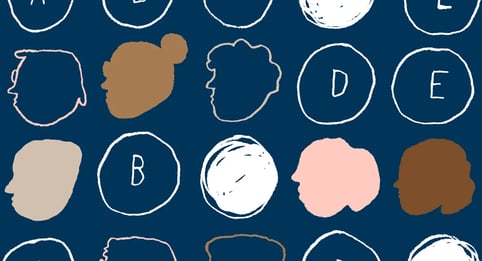

Public education’s singleminded focus on working toward the “Test” also manifests in the disregarding of the arts and humanities. Since standardized testing is heavily tied to whether a school is viewed as “low performing” or “high performing,” if a school begins to show signs of low test scores, funding will be pulled, with the first places targeted being the arts and humanities. This scene has been replayed across America, with it becoming common sense that when funding is cut, the arts and humanities are the first to go. This amounts to a suffocation of arts and humanities, but also a reinforcement of the status quo. Since the owning class is focused on maximizing profits at all costs, they scrutinize public institutions, such as public education, and see what methods guarantee high future profits. In this, the arts and humanities are seen as wasteful, as the owning class has no need for “cultured” or “worldly” students, but workers. Therefore, the arts and humanities are given less priority under more profitable and marketable skills that come with being proficient in math or science. This reinforces the singleminded goal of working toward the “Test.” Furthermore, by suffocating the arts and humanities, the owning class is limiting the possibilities of people questioning and openly challenging the status quo. You see, education was recognized by the famous writer and civil rights activist James Baldwin as paradoxical. As Baldwin noted, the point of education is to be able to think critically and analyze the subject at hand. This is most apparent in the arts and humanities, which focus on abstract critical analysis, questioning the form, meaning, and purpose of the subject material. In this, the arts and humanities can give students the power to think and view their surroundings critically. However, under our present economic system, the owning class cannot tolerate a critical analytical population, as that can be a hotbed for ideas that oppose the status quo. This causes the ideals of education to come into direct conflict with the nature of our present economic system, for if working people are educated, then they will begin to question the myriad of social dynamics that exist. This questioning of the status quo is highly feared and has faced intense pushback, with its opponents calling this questioning “woke” to create a “boogeyman” for working people to fear in order to destroy any thought or behavior that would challenge the status quo. In this, American education reinforces the status quo, leaving students ripe to become tools of the owning class—a population devoid of knowledge is a controllable population, and a controllable population is a profitable one.
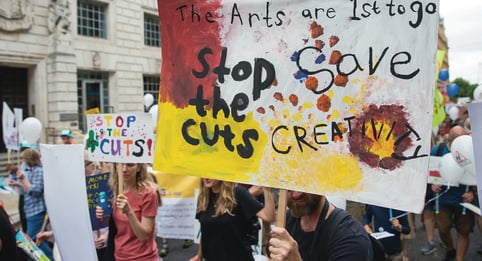

A smaller, but equally important aspect of modern schooling is the decrease in the quality of school food and the rising trend of “lunch debt.” The quality of food in public schools has been on the decline for many years, with much of the food that students are given being unappetizing and of questionable nutritious value. As a result, the decrease in food quality means that students are receiving fewer nutrients, meaning that their bodies are receiving fewer resources than required to function. To make matters worse, children are experiencing debt in the form of “lunch debt,” or the amount of money they owe if they don’t pay for their lunch. This debt isn’t a few dollars or tens of dollars, but amounts to hundreds, if not thousands, of dollars collectively. There have been many news stories that place a spotlight on a kid who recognizes how their classmates can’t afford to eat at the school and how this student raised money to pay off these students’ lunch debt. These stories focus solely on the kid who raised the money, with them praising the child and repeatedly stating how “awesome” it is that they decided to do this. What these stories don’t point out is that a child shouldn’t be paying off debt, especially debt tied to school lunches. These stories should ask these questions: why is it that the richest country in the world has news stories of children paying off school lunch debt? Public education is supposed to be a public good, meaning that all services it provides should be for the welfare of the people, but if students are accruing lunch debt, what does that say about our society and about public education? The increasing trend of lunch debt is placing the burden of providing food to children at school onto the children and their families, who are already often struggling to make ends meet.
An aspect of American public education that is often ignored is that the workplace of public education is still undemocratic. Our society zealously professes an unwavering devotion to the principles of freedom and democracy, and yet, public education, supposedly the place that makes us into proper freedom-loving citizens, had to be forced to allow some measure of democracy in the workplace through teachers and staff unionizing throughout American history. Even though teachers are unionized, giving them some democratic control over their workplaces, the fact remains that their power is limited as many states and counties have passed laws that legally bar public service workers from striking in any situation. This means that the strike, a powerful tool that represents the power that workers have in the production of a good or service, is stolen from teachers and staff. This has resulted in teachers and staff having to use creative, but very roundabout and risky ways of making their voices heard, with a keen example being that teachers during the “Red for Ed” movement—a campaign for better working conditions—had to call in sick, using precious sick days, in order to ensure their demands were heard.
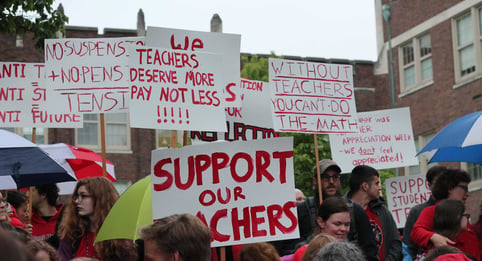

Even with all the control the owning class has over public education, since the government is a vehicle of their interests, they still seek to target and erode away public education because they can’t stand what it represents. Public education is an eyesore for the owning class, a constant reminder that there is a pool of potential profits just waiting to be cracked open by privatizing public education. However, the owning class and their allies can’t say that, so they instead say that public education, or any social service, should be privatized because the free market can better satisfy the needs and wants of the public. This is all a lie to cover their real aim of maximizing profits at the expense of all working people. Public education is fighting against privatization from within and without. Within public education, services that schools would provide, such as custodial services, can be outsourced to a company under the pretext of “reducing cost” and “maximizing quality”; however, because the company is there to make a profit, it is less worried about ensuring a quality job and more about ensuring their contract with the school will be profitable. The result is, as expected, poor, with the outsourced work negatively affecting children and the staff. Outside of public education, its privatized counterpart is taking root all over the country, with the most well-known being the charter schools. Charter schools are independent, private institutions that receive public funding to operate and are advertised as an “alternative” to public education; however, charter schools are mired in controversy left and right, with people questioning how effective they truly are as an educational institution. So, in addition to receiving funding cuts, which target systems that are desperately needed to keep everything functioning, public schools are also having that much-needed funding siphoned off by an entity with a questionable educational record that can make its own rules that benefit the owners of the charter schools rather than the students.
Another troubling facet of modern public education is the overbearing presence of the military in our schools. Everyone, at one point or another, has been approached by a recruiter who will say pretty much anything to get you to enlist in the military. Often, these recruiters will highlight the benefits of enlisting, such as paying for college tuition. Since most high school students don’t have the means to attend higher education and live on their own, the benefits that these recruiters speak of are quite enticing. However, that's the issue: the average working person doesn’t have access in their day-to-day life to any of the benefits that the military provides. This tells us two things: 1. the government can very much provide these services to working people, but does not, and 2. in order to even get access to these services, one has to enlist in the armed forces, risking their own physical and mental well-being, in addition to engaging in imperialism abroad for the benefit of the owning class. This is despicable. Placing these benefits behind enlisting is a predatory practice that is clearly designed to pressure young people into joining the military industrial complex. In this, the presence of the military in schools isn’t to help these students find a career or determine their path in life, but to ensure the owning class has manpower for its imperialist actions abroad.
The military is not the only thing that shouldn’t exist in schools: school resource officers (SROs) should not be in our schools. An SRO is an armed law enforcement officer with arresting powers who is stationed at a school to supposedly keep the peace and protect all those inside the school from harm. With policing in the country being a tool of the owning class used to corral and control working people, it is entirely unacceptable that SROs are allowed to exist at all. Time after time again, we hear cases of police brutality across the country, putting on full display that cops are a far more dangerous threat to public safety than the people they supposedly protect the public from. Similarly, the presence of an SRO creates an atmosphere of surveillance and tension, as the SRO can, at any point, bring their powers as law enforcement officers to bear on children who are misbehaving. These feelings of surveillance and tension are most experienced by students of color and other marginalized communities, who have long histories of being targeted and brutalized by the police—a situation that SROs bring into schools with their presence. In this, an SRO continues the school tradition of punitive methods in addressing behavior issues instead of proven scientific methods that decrease repetitive behavior problems. This entire situation culminates in the creation and maintenance of a prison-like environment. This prison-like environment is only reinforced by the sad reality that some schools have been designed by the same architects who have designed prisons.
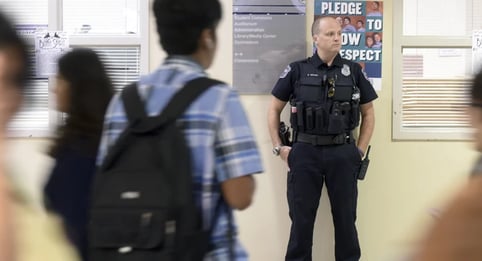

In our world, which is designed for and ruled by the owning class, the state of our public schools is deplorable, with schools mainly serving to reinforce the status quo of exploitation and oppression; however, in a world designed for and ruled by the working class, this wouldn’t be the case. In a world for the working class, public education and all public services would be properly funded because they benefit the whole of the working class. With this funding, public education would have the resources to function as efficiently as possible, providing every staff member and teacher the support and resources they need to do their jobs and provide every student the means to learn and succeed in their own way. Additionally, since the major issues affecting public education—the owning class and their policies—no longer govern society, there would no longer be an attempt to paint teachers as the scapegoat, allowing teachers, parents, and students the ability to unite and formulate plans that benefit the students. This would result in the cold and impersonal form of standardized testing we hyper-fixate on in our society becoming a thing of the past, with students being able to explore the arts and humanities to their fullest extent, providing students with a cultural enrichment unheard of in this country. With this, all students will be able to enjoy the fruits that education has to offer, giving them the skills and knowledge to go and do amazing things for society. Moreover, with the realization of a democratic society, the old dictatorial methods of organizing society will be dismantled and will fade away. The result is that teachers and staff will have the power to truly shape their workplace. In this, the democratic character of the school workplace would trickle down into the classroom, resulting in a more collective shaping of the classroom, where both teacher and students play vital roles in shaping the classroom environment. Moreover, the arrival of a world for working people would end military recruiting in schools and the existence of SROs, as this world would be built upon and reinforced by cooperation, not subjugation and domination. In a world for working people, public education would be a public good that would serve the welfare of all.
For a real world example of what education can look like under a society designed for and governed by the working class, we can look at Cuba. To begin, public education, including college/university education, is 100% covered by the Cuban government, meaning that schools across the island are ensured that they will have the funding they need to operate effectively. The results of this funding can be seen with Cuba having one of the highest literacy rates in the world. Yet, this funding represents something even bigger: since all education is covered by the government, no child is denied access to education, making schooling in Cuba far more inclusive and concerned with the well-being of its students and society. This is only strengthened by the collectivist mindset of the Cuban people (a result of the society being ruled by the working class) in which the ties between teachers, families, students, and schools are promoted and built. This is simply one aspect of Cuban society that demonstrates the positive effects of living in a society for the working class. Other countries where working people have power, like Vietnam and Laos, have similar systems of education.
For millennia, education has been reserved for the minority ruling class of each society, while the majority oppressed and laboring masses never had the chance to experience it. This is our chance to change that. Education is a source of power—a power the owning class is aware of and keeps very much restricted in order to keep themselves in power. So, while public education in the US presents itself as being for the masses, it isn’t; however, because education, like many other institutions, is a source of power, it's a battleground for the class struggle that must be fought. By fighting for education reforms, by fighting to maintain DEI initiatives, by fighting to improve the working conditions of teachers and school staff, by fighting to empower students in schools, by fighting to unite parents, teachers, and students, we are demanding as a united class the right to enjoy the fruits of education—a right that is inextricably tied to the demand and right, as the producers of society, to govern the world and our future. The war against public education must be repelled and overcome by a war for public education, for a militant labor movement, for working class liberation. In doing this, we continue our long, but hopeful march toward a world for working people and a world where every single child can experience the beauty and power of education.
